Scenario Modelling of the “Green” Economy in an Economic Space
Abstract
:1. Introduction
2. Materials and Methods
3. Results
4. Discussion
5. Conclusions
- -
- compilation of annual ratings of regions on the level of development of the “green” economy;
- -
- creation of an analytical rating of economic areas within a regional entity;
- -
- improving the processing of modelling results and increasing their sensitivity;
- -
- upgrading the GUI of the model.
Author Contributions
Acknowledgments
Conflicts of Interest
References
- Crandall, R.E.; Crandall, W.R.; Chen, C.C. Principles of Supply Chain Management, 2nd ed.; CRC Press: Boca Raton, FL, USA, 2015; 704p, ISBN 9781482212051. [Google Scholar]
- The United Nations. Available online: http://www.un.org/en/index.html (accessed on 15 August 2017).
- The European Environment Agency. Available online: https://www.eea.europa.eu/ (accessed on 15 August 2017).
- The World Bank. Available online: http://www.worldbank.org/ (accessed on 15 August 2017).
- The United Nations Development Programme. Available online: http://hdr.undp.org/en/content/human-development-index-hdi (accessed on 15 August 2017).
- The Organisation for Economic Co-Operation and Development. Available online: http://www.oecd.org/ (accessed on 15 August 2017).
- The Global Footprint Network. Available online: https://www.footprintnetwork.org/our-work/ecological-footprint/ (accessed on 15 August 2017).
- The United Nations Commission on Sustainable Development. Available online: https://sustainabledevelopment.un.org/csd.html (accessed on 15 August 2017).
- The Socioeconomic Data and Applications Center. Available online: http://sedac.ciesin.columbia.edu/data/collection/esi/ (accessed on 15 August 2017).
- Van de Kerk, G. A Comprehensive Index for a Sustainable Society: The SSI—The Sustainable Society Index. Available online: http://citeseerx.ist.psu.edu/viewdoc/download?doi=10.1.1.536.9996&rep=rep1&type=pdf (accessed on 15 August 2017).
- The Environmental Performance Index. Available online: https://epi.envirocenter.yale.edu/ (accessed on 15 August 2017).
- The Eight Millennium Development Goals. Available online: http://www.un.org/millenniumgoals/ (accessed on 15 August 2017).
- Sustainable Development Goals. Available online: http://www.un.org/sustainabledevelopment/sustainable-development-goals/ (accessed on 15 August 2017).
- Martyshina, T.V. Providing Stability of Development of the Region in the Conditions of an Astable Environment. Ph.D. Thesis, Adyghe State University, Maykop, Russia, 2014. [Google Scholar]
- Costanza, R.; Cumberland, J.; Daly, H.; Goodland, R.; Norgaard, R. An Introduction to Ecological Economics; CRC Press LLC: Boca Raton, FL, USA, 1997; p. 275. ISBN 1-884015-72-7. [Google Scholar]
- Costanza, R.; Cumberland, J.H.; Daly, H.; Goodland, R.; Norgaard, R.B. An Introduction to Ecological Economics; St. Lucie Press: Boca Raton, FL, USA; International Society for Ecological Economics: Boston, MA, USA, 2014; p. 356. ISBN 9781566706841. [Google Scholar]
- Edwards, A.E.; Orr, D.W. The Stability Revolution: Portrait of a Paradigm Shift; New Society Publishers: Gabriola, BC, Canada, 2005; p. 206. ISBN 9780865715318. [Google Scholar]
- Surkova, S.A. Ecological and Economic Aspects of Scientific and Technical Policy. Available online: http://www.uran.ru/reports/2005/3dic_2004/section2/s2p146.htm (accessed on 21 August 2017).
- Čábelková, I.; Kiseleva, L.; Strielkowski, W. Study of influence of socio-demographic characteristics of workers on job satisfaction (the case of the Czech Republic). Hum. Ecol. 2015, 4, 39–46. [Google Scholar]
- Kiseleva, L.S.; Strielkowski, W. Economic analysis of happiness, wellbeing and health: A Tyumen region case study. Actual Probl. Econ. 2014, 11, 245–254. [Google Scholar]
- Kolmakov, V.V.; Polyakova, A.G.; Shalaev, V.S. An analysis of the impact of venture capital investment on economic growth and innovation: Evidence from the USA and Russia. Econ. Ann. 2015, LX, 7–37. [Google Scholar] [CrossRef]
- Bobylev, S.N.; Minakov, V.S.; Solovieva, S.V.; Tretyakov, V.V. Ecological and Economic Index of Russian Regions. 2013. Available online: https://new.wwf.ru/upload/iblock/dc8/index.pdf (accessed on 21 August 2017).
- Gurman, V.I. System analysis of sustainable development strategies. Bull. Buryat State Univ. 2012, 1, 47–53. [Google Scholar]
- Dorgushaova, A.K. The economic framework of the territory of innovation-oriented development: A structural model, institutes and mechanisms of formation. Ph.D. Thesis, Maykop State Technological University, Maykop, Russia, 2016. [Google Scholar]
- Ginis, L.A. The Origins of Modern Cognitive Modeling. Available online: https://cyberleninka.ru/article/n/istoki-sovremennogo-kognitivnogo-modelirovaniya (accessed on 21 August 2017).
- Rudneva, L.N.; Pchelintseva, I.G.; Gureva, M.A. General Tendencies in Modern Economy: Sustainable Development and Green Economy. J. Environ. Manag. Tour. Q. 2016, 7, 231–233. [Google Scholar]
- Rudneva, L.N.; Pchelintseva, I.G.; Gureva, M.A. The Indicative System of Assessing the Level of Ecologization in the Context of the Region’s Sustainable Development. Int. J. Econ. Financ. Issues 2016, 6 (Suppl. S1), 227–232. [Google Scholar]
- Gureva, M.A.; Simarova, I.S. Methodological approach to assessing the development of the "green" economy in the economic space. Sci. Bus. Ways Dev. 2016, 10, 90–103. [Google Scholar]
- Unified Interagency Information and Statistical System. Available online: https://fedstat.ru/ (accessed on 21 August 2017).
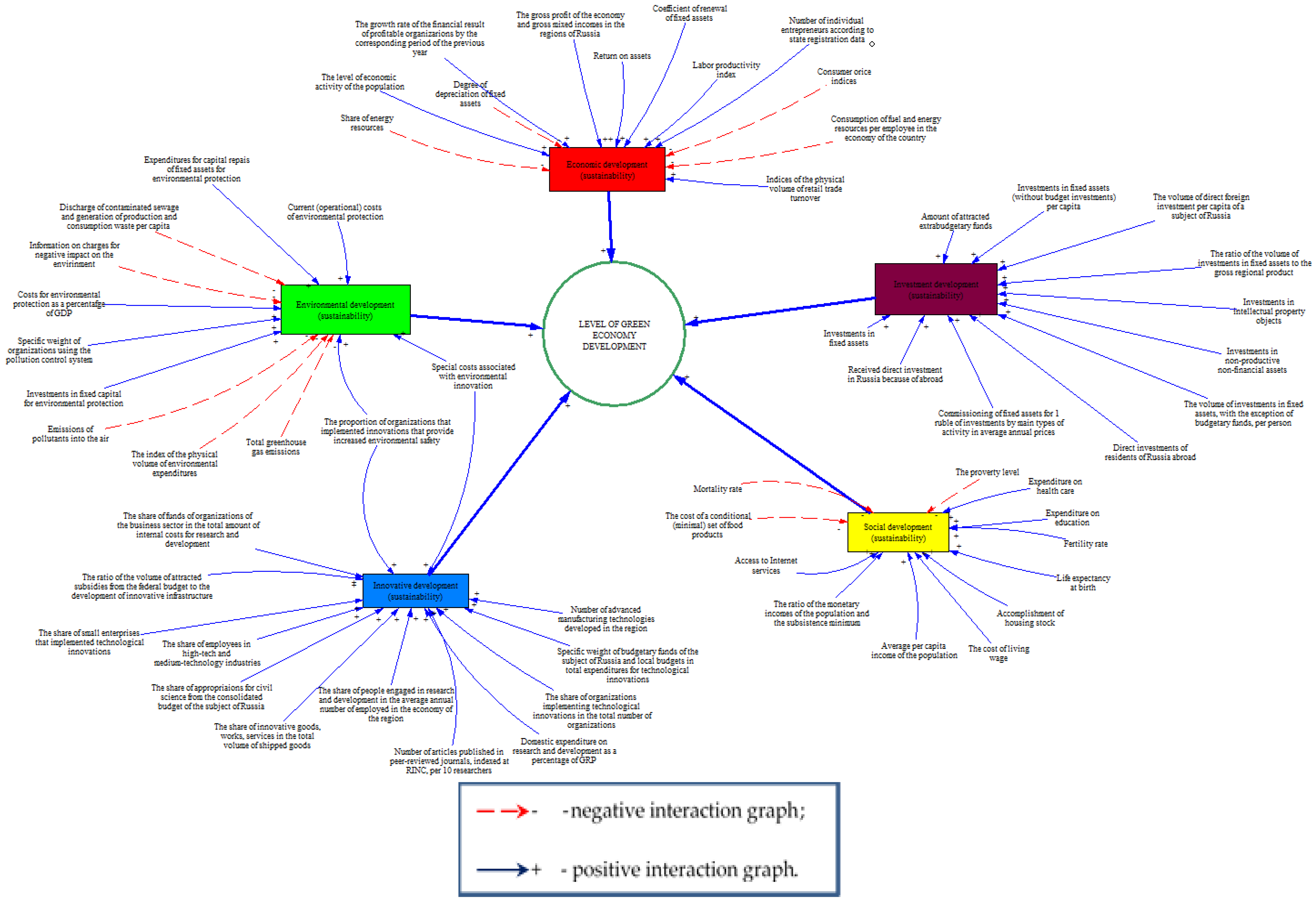
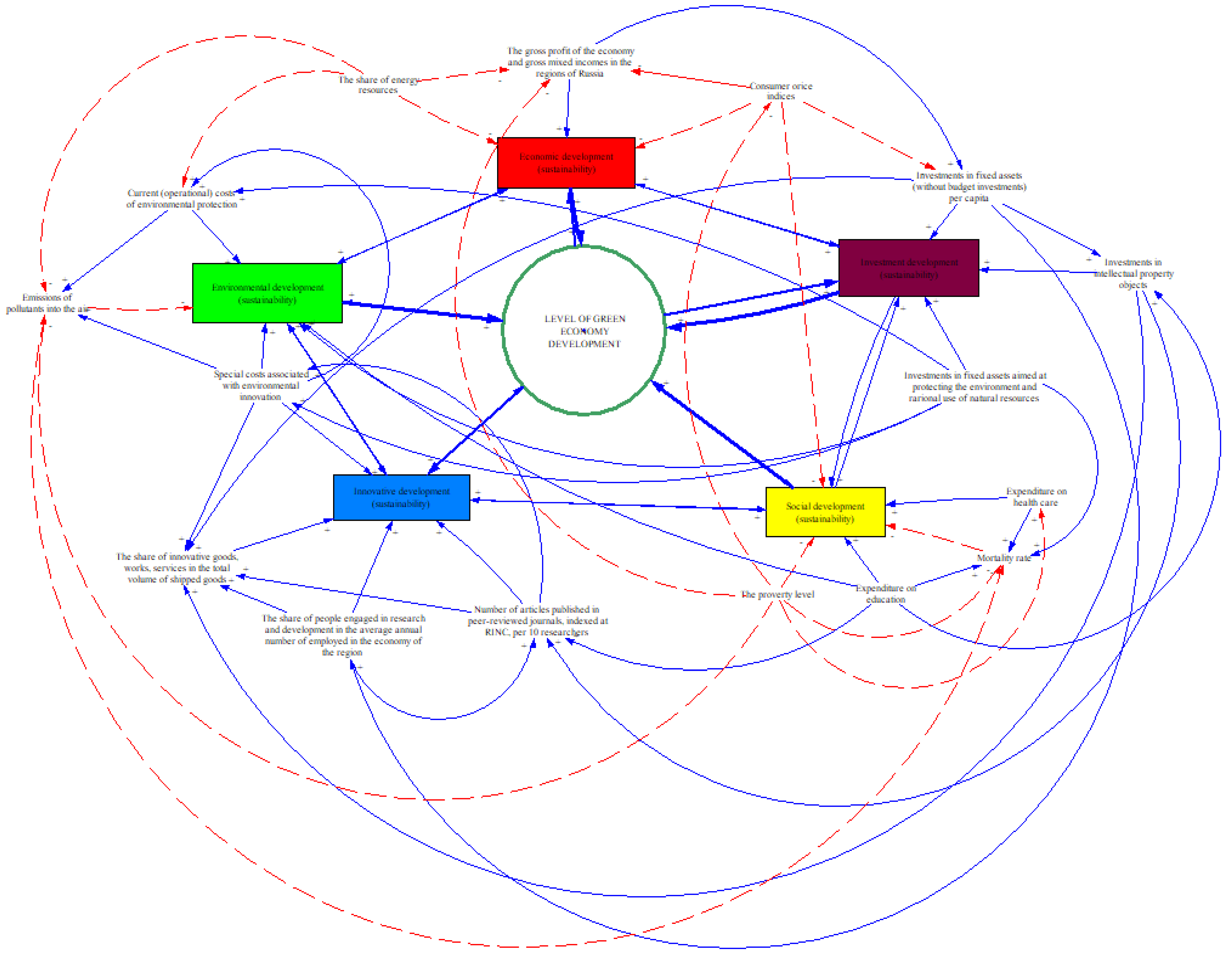
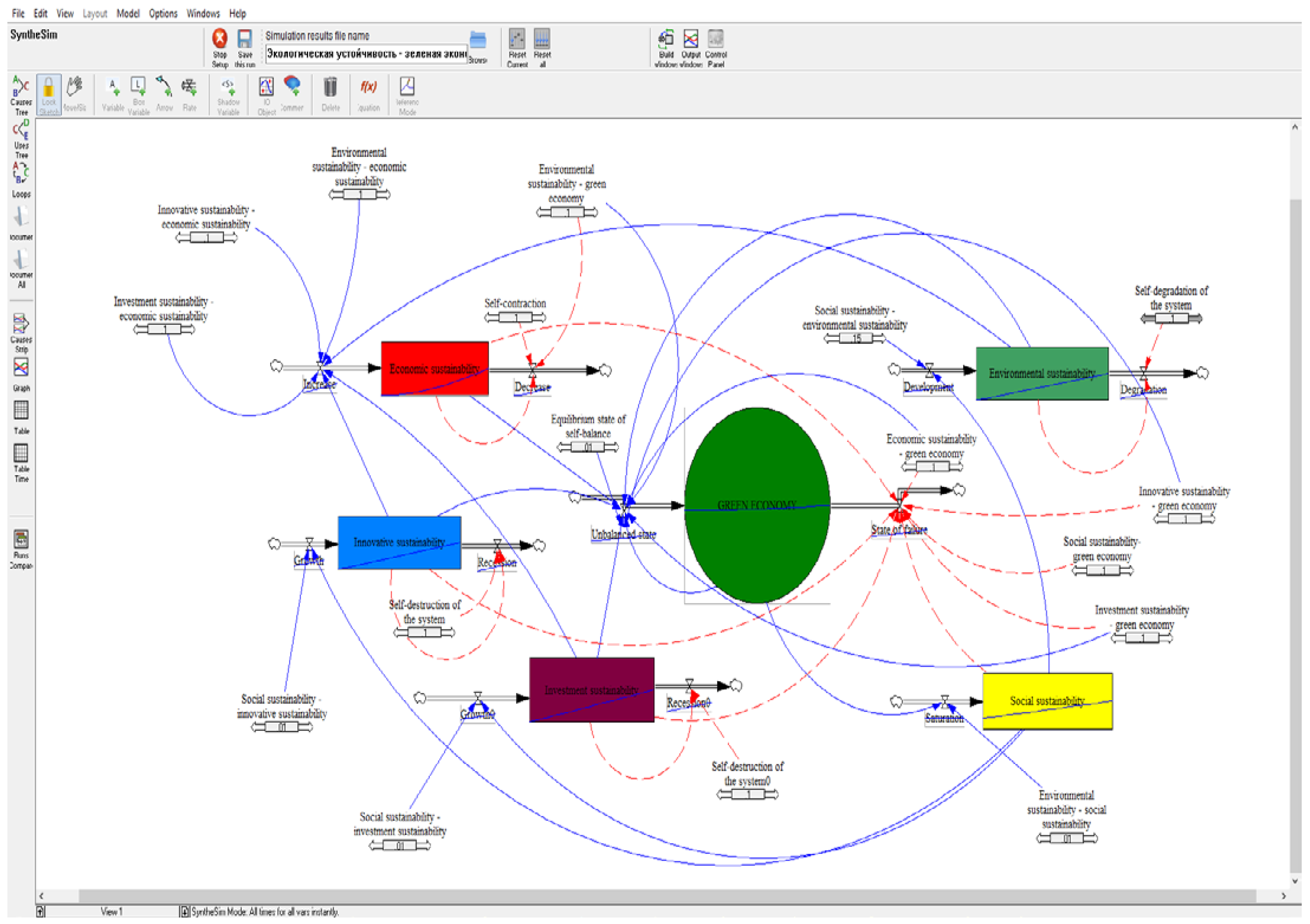

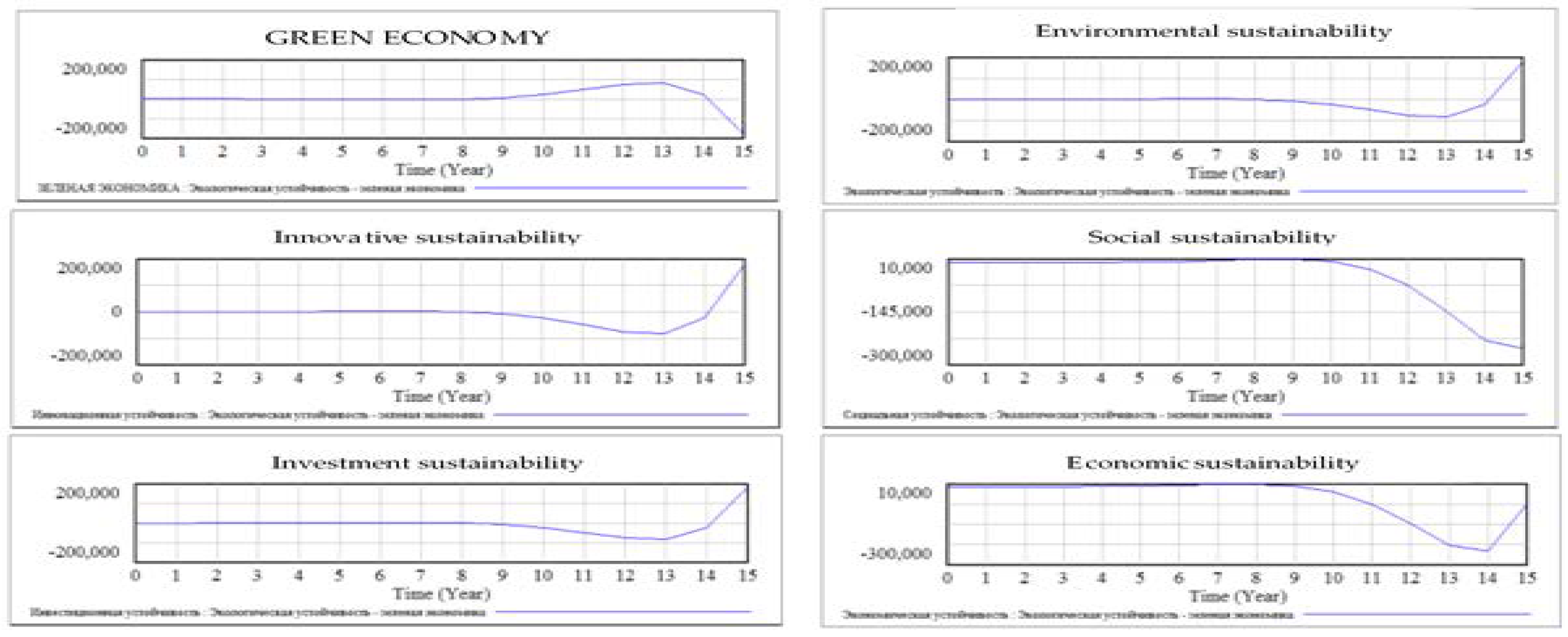
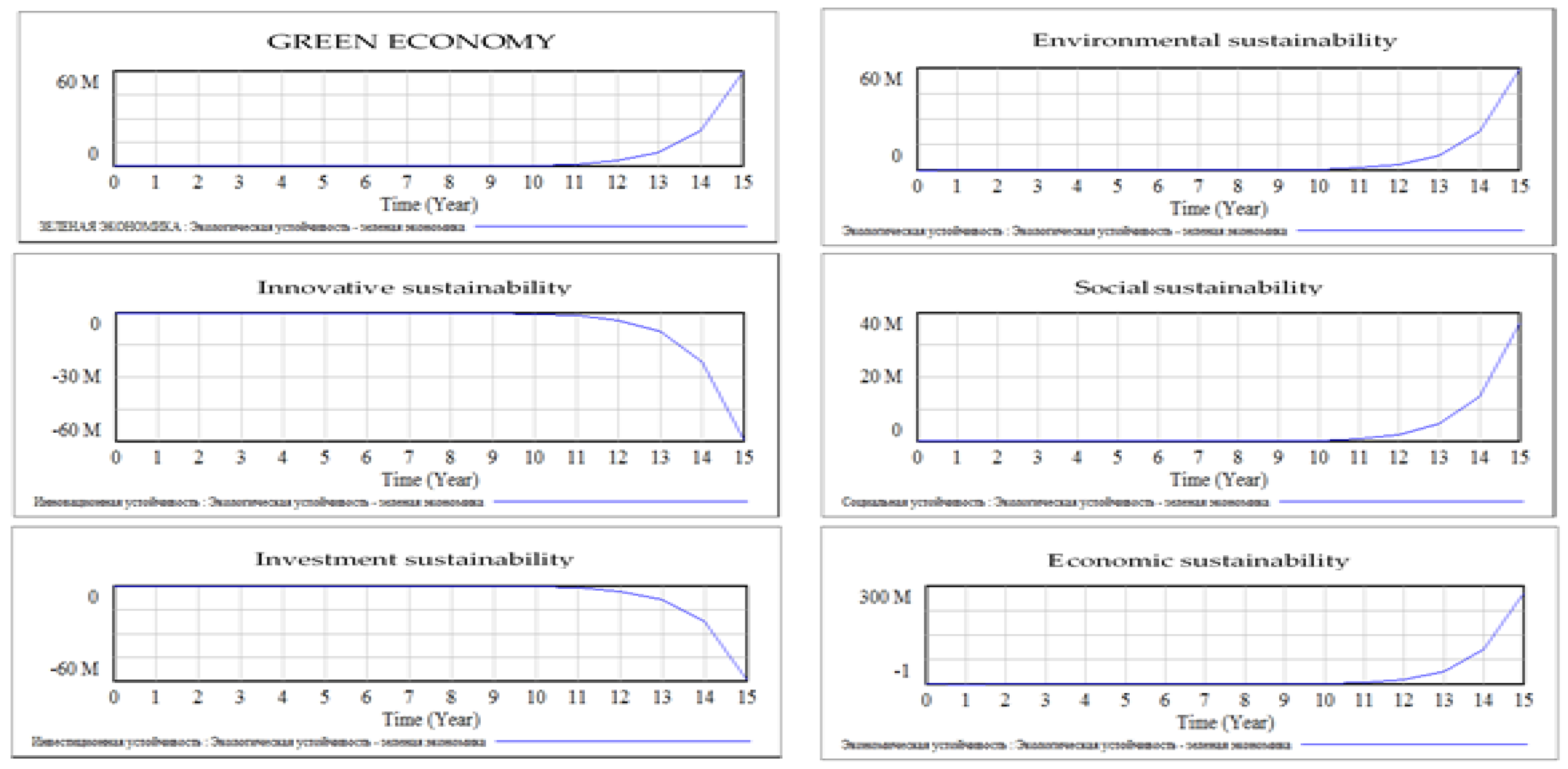
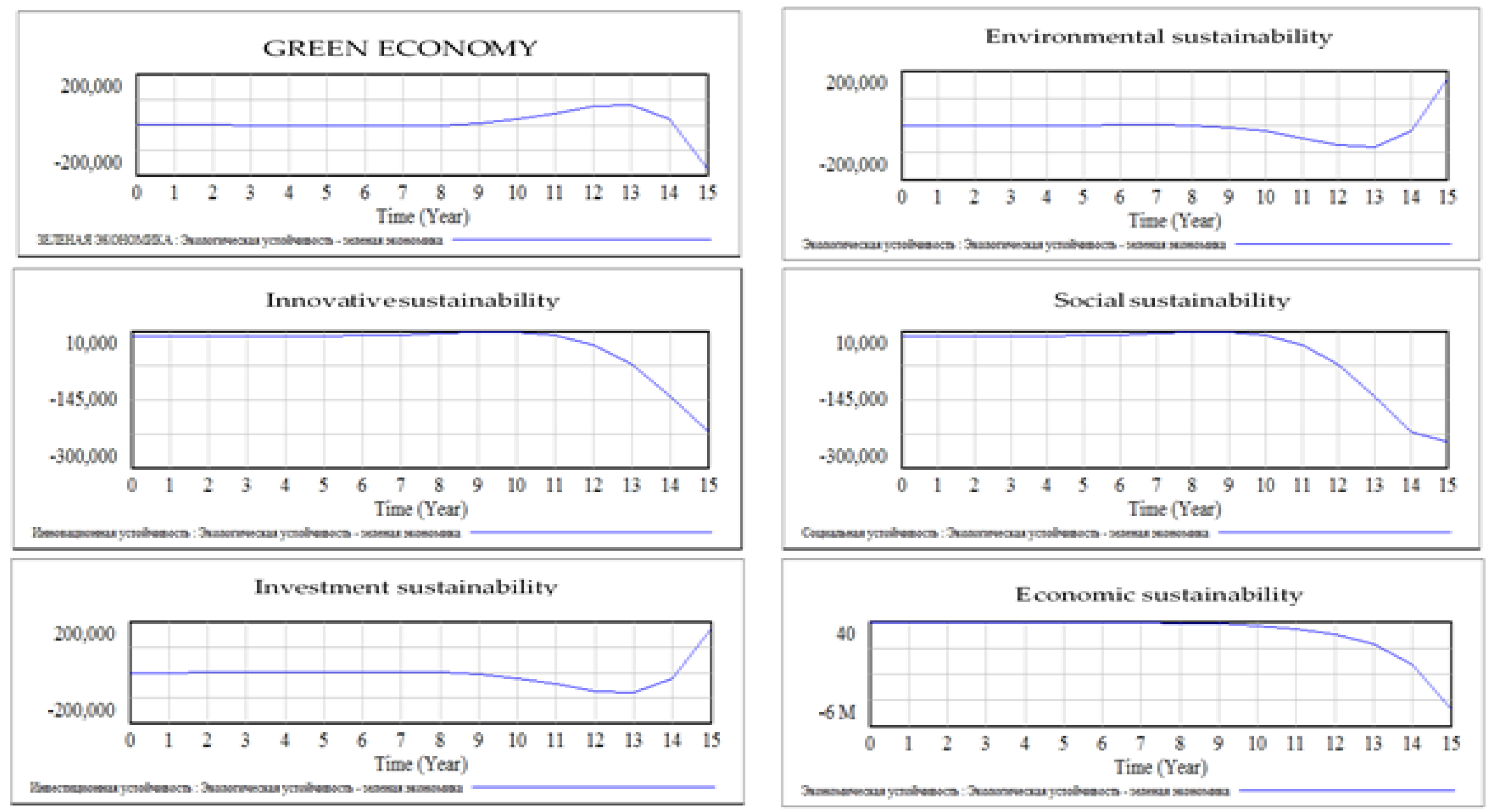
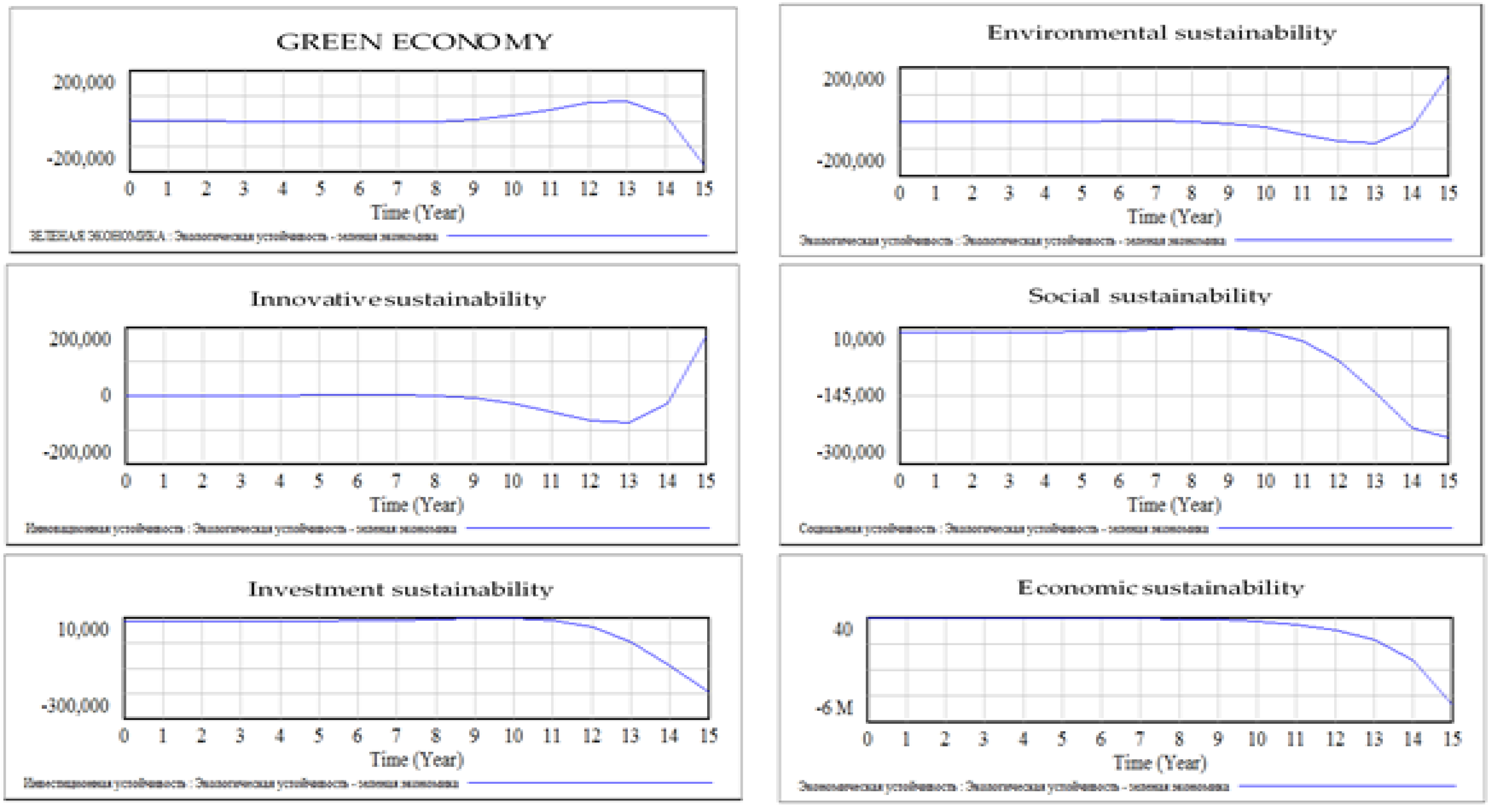
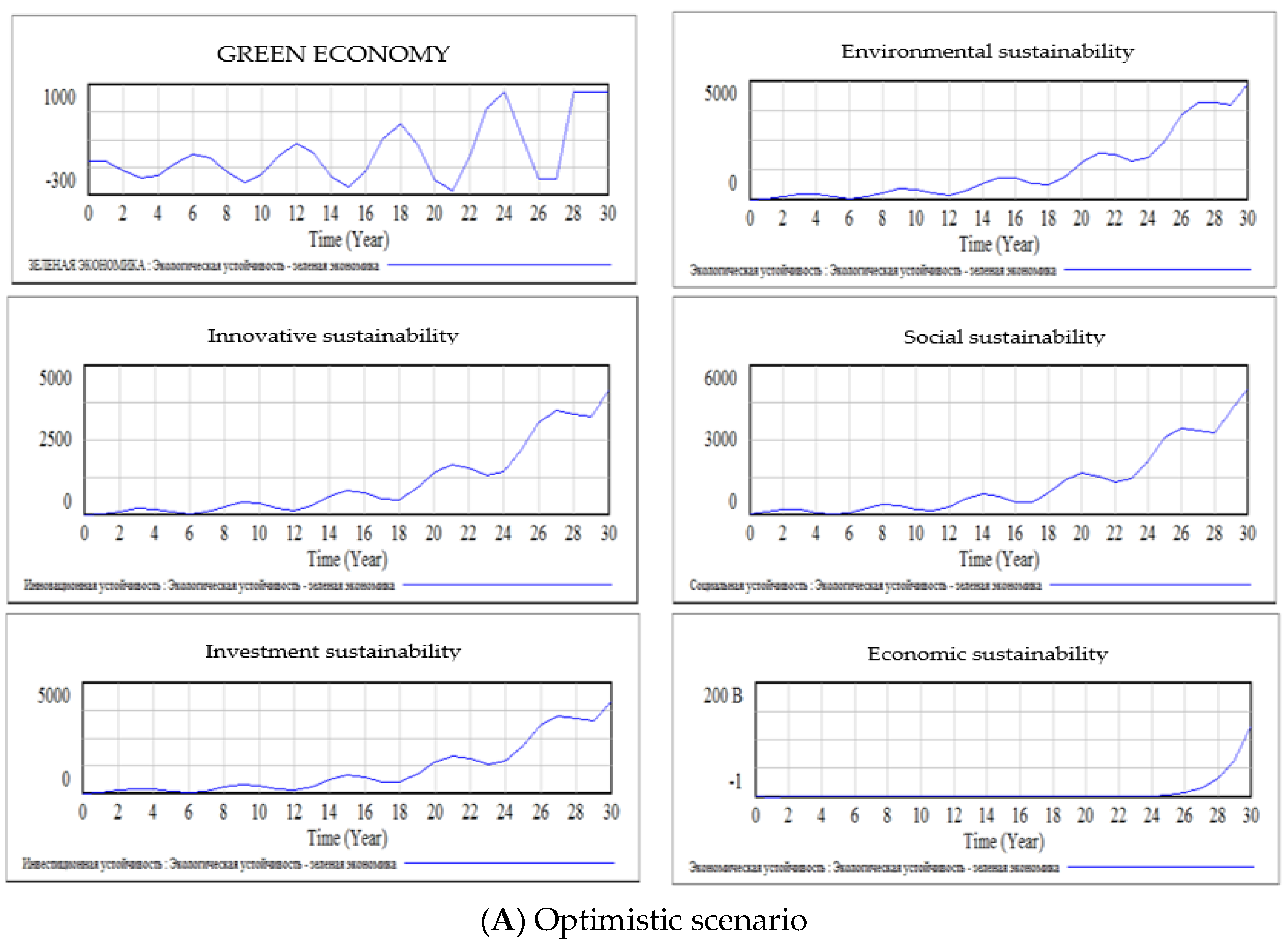

| Name of the “Vertex” and Symbols of the Cognitive Map | Conceptual Elements (Indicators and Their Symbols) on the Cognitive Map * | Functional Dependence |
|---|---|---|
| Level of the “green” economy development IRGE (IRegional Green Economy) | - economic development (stability)—A, обратное—A’; - social development (stability—C, reverse—С’; - ecological development (stability)—B, reverse—В’; - innovation development (stability)—D, reverse—D’; - investment development (stability)—F, reverse—F’. | |
| Economic development (stability) А | - gross profit of the economy and gross mixed incomes in the regions of the RF **—А5; - labor productivity index—А8; - indices of the physical volume of retail trade turnover—А12; - consumer price indices **—А10; - share of energy resources produced using renewable energy sources in total energy production **—А1; - coefficient of renewal of fixed assets—А7; - degree of depreciation of fixed assets—А3; - level of economic activity of the population—А2; - return on assets—А6; - growth rate of the financial result of profitable organizations by the corresponding period of the previous year—А4; -index of the number of individual entrepreneurs according to state registration data—А9; - consumption of fuel and energy resources per employee in the economy of the country—А11. | |
| Social development (stability) C | - subsistence level—С6; - per capita monetary income of the population—С5; - ratio of monetary incomes of the population and the subsistence minimum—С4; - poverty level **—С12; - birth rate—С9; - death rate **—С1; - life expectancy at birth—С8; - value of a conditional (minimal) set of food products—С2; - education expenditure index **—С10; - health expenditure index **—С11; - index of improvement of housing stock—С7; - access to internet services, depending on the level of average per capita disposable resources, for 10 percent groups of the population—С3. | |
| Ecological development (stability) B | -share of current (operational) costs for environmental protection **—В1; - share of expenses for capital repairs of the basic funds for environmental protection—В2; - environmental costs as a percentage of GDP—В5; - index of the physical volume of environmental expenditures—В9; - share of investments in fixed assets aimed at environment protection and rational use of natural resources—В7; - share of organizations that carried out innovations ensuring increased environmental safety in the production of goods, works, services, in the total number of organizations that carried out environmental innovations—В11; - share of organizations using the system for monitoring environmental pollution in the total number of organizations—В6; - special cost index associated with environmental innovation **—В12; - index of fee for negative impact on the environment (environmental payments)—В4; - emissions of pollutants into the air **—В8; - discharge of contaminated sewage and generation of production and consumption wastes per capita—В3; -aggregate greenhouse gas emissions index—В10. | |
| Innovation development (stability) D | - share of funds of organizations of the business sector in the total amount of internal costs for research and development—D1; - share of employed in high-tech and mid-tech high-level industries of production in the total number of employed in the economy of the region—D2; - domestic expenditure on research and development as a percentage of GRP—D3; - share of employed in research and development in the average annual number of employed in the economy of the region **—D4; - share of organizations that carried out technological innovation in the total number of organizations (by industrial production organizations)—D5; - share of small enterprises that carried out technological innovations in the total number of small enterprises—D6; - share of innovation goods, works, services in the total volume of goods shipped, works and services performed (by organizations of industrial production) **—D7; - ratio of the amount of subsidies raised from the federal budget for the development of innovation infrastructure for small- and medium-sized businesses to GRP—D8; - share of budgetary funds of the subject of the RF and local budgets in total costs for technological innovations—D9; - share of appropriations for civil science from the consolidated budget of the subject of the RF in the expenditures of the consolidated budget of the subject of the RF—D10; - number of advanced manufacturing technologies developed in the region, per million of economically active population—D11; - number of articles published in peer-reviewed journals indexed at RSCI, per 10 researchers **—D12. | |
| Investment development (stability) F | - index of investments in fixed assets (without budget investments) per capita **—F1; - index of investment in intellectual property **—F2; - index of investment in fixed assets—F3; - index of investment in non-produced non-financial assets—F4; - index of investment in fixed assets aimed at environment protection and rational use of natural resources **—F5; - index of investments of direct investments of residents of the RF abroad by instruments and partner countries—F6; - index of direct investment in Russia from abroad—F7; - index of fixed assets put into operation per 1 ruble of investments by main types of activity in average annual prices—F8; - ratio of the volume of investments in fixed assets to the gross regional product—F9; - amount of attracted extrabudgetary funds—F10; - volume of investments in fixed assets, excluding budgetary funds, per person—F11; - volume of direct foreign investments per 1 resident of a subject of the RF—F12. |
| “Vertex” of the Cognitive Map | Input Pulses | Output Pulses | ||
|---|---|---|---|---|
| «+» | «−» | «+» | «−» | |
| Level of the “green” economy development | A, B, C, D, F | - | A’, B’, C’, D’, F’ | - |
| Economic development (stability) | A2, A4, A5, A6,A7, A8, A9, A12 | A1, A3, A10, A11 | A | - |
| Ecological development (stability) | B1, B2, B5, B6, B7, B11, B12 | B3, B4, B8, B9, B10 | D | - |
| Social development (stability) | C3, C4, C5,C6, C7, C8, C9, C10, C11 | C1, C2, C12 | C | - |
| Innovation development (stability) | D1, D2, D3,D4, D5, D6, D7, D8, D9, D10, D11, D12 | - | D | - |
| Investment development (stability) | F1, F2, F3,F4, F5, F6, F7, F8, F9, F10, F11, F12 | - | F | - |
| Name and Symbols of the “Vertex” of the Cognitive Map | 1 | 2 | 3 | 4 | 5 | 6 | 7 | 8 | 9 | 10 | 11 | 12 | 13 | 14 | 15 | 16 | 17 | 18 | 19 | 20 | 21 | 22 |
|---|---|---|---|---|---|---|---|---|---|---|---|---|---|---|---|---|---|---|---|---|---|---|
| 1. Level of the “green” economy development | A | P | P | P | P | P | A | A | A | A | A | A | A | A | A | A | A | A | A | A | A | A |
| 2. Economic development (stability) | P | A | P | P | P | P | A | A | A | A | A | A | A | A | A | A | A | A | A | A | A | A |
| 3. Social development (stability) | P | P | A | P | P | P | A | A | A | A | A | A | A | A | A | A | A | A | A | A | A | A |
| 4. Ecological development (stability) | P | P | P | A | P | P | A | A | A | A | A | A | A | A | A | A | A | A | A | A | A | A |
| 5. Innovation development (stability) | P | P | P | P | A | P | A | A | A | A | A | A | A | A | A | A | A | A | A | A | A | A |
| 6. Investment development (stability) | P | P | P | P | P | A | A | A | A | A | A | A | A | A | A | A | A | A | A | A | A | A |
| 7. Gross profit of the economy and gross mixed incomes in the regions of the RF | A | P | A | A | A | A | A | A | A | A | A | A | A | A | A | A | A | A | A | P | A | A |
| 8. Consumer price indices | A | N | N | A | A | A | N | A | A | A | A | A | A | A | A | A | A | A | A | N | A | A |
| 9. Share of energy resources produced using renewable energy sources in total energy production | A | N | A | A | A | A | N | A | A | A | A | A | A | N | A | N | A | A | A | A | A | A |
| 10. Poverty level | A | A | N | A | A | A | N | N | A | A | N | A | N | A | A | N | A | A | A | A | A | A |
| 11. Death rate | A | A | N | A | A | A | A | A | A | A | A | A | A | A | A | A | A | A | A | A | A | A |
| 12. Education expenditure | A | A | P | P | A | A | A | A | A | A | P | A | A | A | A | A | A | A | P | A | P | A |
| 13. Health expenditure | A | A | P | A | A | A | A | A | A | A | P | A | A | A | A | A | A | A | A | A | A | A |
| 14. Current (operational) costs for environmental protection | A | A | A | P | A | A | A | A | A | A | A | A | A | A | A | P | A | A | A | A | A | A |
| 15. Special cost associated with environmental innovation | A | A | A | P | P | A | A | A | A | A | A | A | A | A | A | P | A | P | A | A | A | A |
| 16. Emissions of pollutants into the air | A | A | A | N | A | A | A | A | A | N | A | A | A | A | A | A | A | A | A | A | A | A |
| 17. Share of employed in research and development in the average annual number of employed in the economy of the region | A | A | A | A | P | A | A | A | A | A | A | A | A | A | A | A | A | P | P | A | A | A |
| 18. Share of innovation goods, works, services in the total volume of goods shipped, works and services performed (by organizations of industrial production) | A | A | A | A | P | A | A | A | A | A | A | A | A | A | A | A | A | A | A | A | A | A |
| 19. Number of articles published in peer-reviewed journals indexed at RSCI, per 10 researchers | A | A | A | A | P | A | A | A | A | A | A | A | A | A | P | A | A | P | A | A | A | A |
| 20. Index of investments in fixed assets (without budget investments) per capita | A | A | A | A | A | P | A | A | A | A | A | A | A | A | A | A | P | P | A | A | P | A |
| 21. Index of investment in intellectual property | A | A | A | A | A | P | A | A | A | A | A | A | A | A | A | A | A | P | P | A | A | A |
| 22. Index of investment in fixed assets aimed at environment protection and rational use of natural resources | A | A | A | P | A | P | A | A | A | A | A | A | A | P | P | A | A | A | A | A | A | A |
| Variable Parameter (Cognitive Vertex) | Scenario 1 | Scenario 2 | Scenario 3 * | Scenario 4 | Scenario 5 |
|---|---|---|---|---|---|
| Social stability |  |  |  |  |  |
| Economic stability |  |  |  |  |  |
| Environmental stability |  |  |  |  |  |
| Innovation stability |  |  |  |  |  |
| Investment stability |  |  |  |  |  |
| Green economy |  |  |  |  |  |
 —positive dynamics of changes (growth);
—positive dynamics of changes (growth);  —negative dynamics of changes (decline); * Most Optimal Scenario.
—negative dynamics of changes (decline); * Most Optimal Scenario.© 2018 by the authors. Licensee MDPI, Basel, Switzerland. This article is an open access article distributed under the terms and conditions of the Creative Commons Attribution (CC BY) license (http://creativecommons.org/licenses/by/4.0/).
Share and Cite
Rudneva, L.; Pchelintseva, I.; Gureva, M. Scenario Modelling of the “Green” Economy in an Economic Space. Resources 2018, 7, 29. https://doi.org/10.3390/resources7020029
Rudneva L, Pchelintseva I, Gureva M. Scenario Modelling of the “Green” Economy in an Economic Space. Resources. 2018; 7(2):29. https://doi.org/10.3390/resources7020029
Chicago/Turabian StyleRudneva, Larisa, Irina Pchelintseva, and Maria Gureva. 2018. "Scenario Modelling of the “Green” Economy in an Economic Space" Resources 7, no. 2: 29. https://doi.org/10.3390/resources7020029





